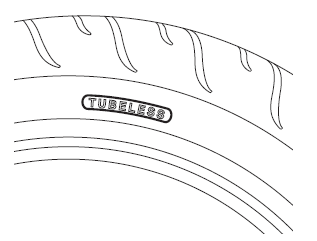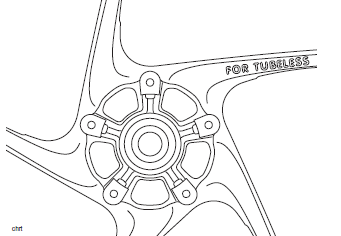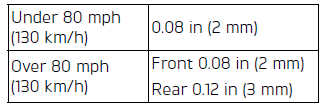 Triumph Street Triple S - Owner's Manual > Tires
Triumph Street Triple S - Owner's Manual > Tires

This model is equipped with tubeless tires, valves and wheel rims. Use only tires marked 'TUBELESS' and tubeless valves on rims marked 'SUITABLE FOR TUBELESS TYRES'.
Warning: Do not install tube type tires on tubeless rims.
The bead will not seat and the tires could slip on the rims, causing rapid tire deflation that may result in a loss of motorcycle control and an accident.
Never install an inner tube inside a tubeless tire without the appropriate marking. This will cause friction inside the tire and the resulting heat buildup may cause the tube to burst resulting in rapid tire deflation, loss of motorcycle control and an accident.

Typical Tire Marking - Tubeless Tire

Typical Wheel Marking - Tubeless Tire
Tire Inflation Pressures
Warning: Incorrect tire inflation will cause abnormal tread wear and instability problems that may lead to loss of control and an accident.
Under inflation may result in the tire slipping on, or coming off the rim.
Overinflation will cause instability and accelerated tread wear.
Both conditions are dangerous as they may cause loss of control leading to an accident.
Warning: Tire pressures which have been reduced for off-road riding will impair on-road stability.
Always make sure that the tire pressures are set as described in the Specification section for on-road use.
Operation of the motorcycle with incorrect tire pressures may cause loss of motorcycle control and an accident.
Correct inflation pressure will provide maximum stability, rider comfort and tire life. Always check tire pressures before riding when the tires are cold.
Check tire pressures daily and adjust if necessary. See the Specification section for details of the correct inflation pressures.
Tire Pressure Monitoring System (TPMS) (if equipped)
Caution: An adhesive label is installed to the wheel rim to indicate the position of the tire pressure sensor.
Care must be taken when replacing the tires to prevent any damage to the tire pressure sensors.
Always have your tires mounted by your authorized Triumph dealer and inform them that tire pressure sensors are installed on the wheels.
Caution: Do not use anti puncture fluid or any other item likely to obstruct air flow to the TPMS sensor's orifices. Any blockage to the air pressure orifice of the TPMS sensor during operation will cause the sensor to become blocked, causing irreparable damage to the TPMS sensor assembly.
Damage caused by the use of anti puncture fluid or incorrect maintenance is not considered a manufacturing defect and will not be covered under warranty.
Always have your tires mounted by your authorized Triumph dealer and inform them that tire pressure sensors are installed on the wheels.
The tire pressures shown on your instruments indicate the actual tire pressure at the time of selecting the display. This may differ from the inflation pressure set when the tires are cold because tires become warmer during riding, causing the air in the tire to expand and increase the inflation pressure. The cold inflation pressures specified by Triumph take account of this.
Only adjust tire pressures when the tires are cold using an accurate pressure gage. Do not use the tire pressure display on the instruments.
Tire Wear
As the tire tread wears down, the tire becomes more susceptible to punctures and failure. It is estimated that 90% of all tire problems occur during the last 10% of tread life (90% worn). It is recommended that tires are changed before they are worn to their minimum tread depth.
Minimum Recommended Tread Depth
Warning: Operation with excessively worn tires is hazardous and will adversely affect traction, stability and handling which may lead to loss of control and an accident.
When tubeless tires, used without a tube, become punctured, leakage is often very slow. Always inspect tires very closely for punctures. Check the tires for cuts, embedded nails or other sharp objects. Operation with punctured or damaged tires will adversely affect motorcycle stability and handling which may lead to loss of control or an accident.
Check the rims for dents or deformation. Operation with damaged or defective wheels or tires is dangerous and loss of motorcycle control or an accident could result.
Always consult your authorized Triumph dealer for tire replacement, or for a safety inspection of the tires.
In accordance with the periodic maintenance chart, measure the depth of the tread with a depth gage, and replace any tire that has worn to, or beyond the minimum allowable tread depth specified in the table below:

Tire Replacement
All Triumph motorcycles are carefully and extensively tested in a range of riding conditions to make sure that the most effective tire combinations are approved for use on each model. It is essential that approved tires and inner tubes (if installed) mounted in approved combinations, are used when purchasing replacement items. The use of non-approved tires and inner tubes, or approved tires and inner tubes in non-approved combinations, may lead to motorcycle instability, loss of control and an accident.
A list of approved tires and inner tubes specific to your motorcycle are available from your authorized Triumph dealer, or on the Internet at www. triumph. co. uk.
Always have tires and inner tubes mounted and balanced by your authorized Triumph dealer who has the necessary training and skills to ensure safe, effective installation.
When replacement tires or inner tubes are required, consult your authorized Triumph dealer who will arrange for the tires and inner tubes to be selected, in a correct combination, from the approved list and mounted according to the tire and inner tube manufacturer's instructions.
Initially, the new tires and inner tubes will not produce the same handling characteristics as the worn tires and inner tubes and the rider must allow adequate riding distance (approximately 100 miles (160 km) ) to become accustomed to the new handling characteristics.
24 hours after mounting, the tire pressures must be checked and adjusted, and the tires and inner tubes examined for correct seating.
Rectification must be carried out as necessary. The same checks and adjustments must also be carried out when 100 miles (160 km) have been traveled after mounting.
Warning: Inner tubes must only be used on motorcycles equipped with spoked wheels and with tires marked 'TUBE TYPE'.
Some brands of approved tires marked 'TUBELESS' may be suitable for use with an inner tube. Where this is the case, the tire wall will be marked with text permitting the installation of an inner tube.
Use of an inner tube with a tire marked 'TUBELESS', and NOT marked as suitable for use with an inner tube, or use of an inner tube on an alloy wheel marked 'SUITABLE FOR TUBELESS TYRES' will cause deflation of the tire resulting in loss of motorcycle control and an accident.
Warning: Do not install tube type tires on tubeless rims.
The bead will not seat and the tires could slip on the rims, causing rapid tire deflation that may result in a loss of motorcycle control and an accident.
Never install an inner tube inside a tubeless tire without the appropriate marking. This will cause friction inside the tire and the resulting heat buildup may cause the tube to burst resulting in rapid tire deflation, loss of motorcycle control and an accident.
Warning: If a tire or inner tube sustains a puncture, the tire and inner tube must be replaced.
Failure to replace a punctured tire and inner tube, or operation with a repaired tire or inner tube can lead to instability, loss of motorcycle control or an accident.
Warning: If tire damage is suspected, such as after striking the curb, ask your authorized Triumph dealer to inspect the tire both internally and externally.
Tire damage may not always be visible from the outside.
Operation of the motorcycle with damaged tires could lead to loss of control and an accident.
Warning: Use of a motorcycle with incorrectly seated tires or inner tubes, incorrectly adjusted tire pressures, or when not accustomed to its handling characteristics may lead to loss of motorcycle control and an accident.
Warning: The ABS system operates by comparing the relative speed of the front and rear wheels.
Use of non-recommended tires can affect wheel speed and cause the ABS function not to operate, potentially leading to loss of motorcycle control and an accident in conditions where the ABS would normally function.
Warning: Accurate wheel balance is necessary for safe, stable handling of the motorcycle. Do not remove or change any wheel balance weights. Incorrect wheel balance may cause instability leading to loss of control and an accident.
When wheel balancing is required, such as after tire or inner tube replacement, see your authorized Triumph dealer.
Only use self-adhesive weights. Clip on weights may damage the wheel, tire or inner tube resulting in tire deflation, loss of motorcycle control and an accident.
Warning: Tires and inner tubes that have been used on a rolling road dynamometer may become damaged. In some cases, the damage may not be visible on the external surface of the tire.
Tires and inner tubes must be replaced after such use as continued use of a damaged tire or inner tube may lead to instability, loss of motorcycle control and an accident.
See also:
 Triumph Street Triple S - Owner's Manual > Suspension
Triumph Street Triple S - Owner's Manual > Suspension
Front Suspension Warning: Make sure that the correct balance between front and rear suspension is maintained. Suspension imbalance could significantly change handling characteristics leading to loss of control and an accident.
 Triumph Street Triple S - Owner's Manual > Battery
Triumph Street Triple S - Owner's Manual > Battery
Warning: The battery contains sulfuric acid (battery acid). Contact with skin or eyes may cause severe burns. Wear protective clothing and a face shield. If battery acid gets on your skin, flush with water immediately.

 Benelli Imperiale 400
Benelli Imperiale 400 BMW F900XR
BMW F900XR Honda CB500X
Honda CB500X KTM 390 Adventure
KTM 390 Adventure Triumph Street Triple S
Triumph Street Triple S Yamaha MT-03
Yamaha MT-03 Kawasaki Z400
Kawasaki Z400 Triumph Street Triple S
Triumph Street Triple S Yamaha MT-03
Yamaha MT-03